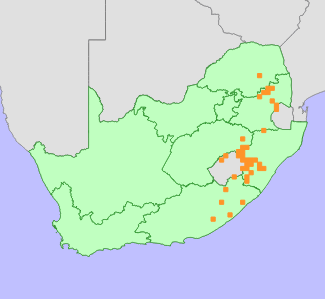|
Scientific Name | Pterygodium hastatum Bolus |
Higher Classification | Monocotyledons |
Family | ORCHIDACEAE |
Common Names | 'Mametsana-a-manyenyane (ss) |
National Status |
Status and Criteria | Least Concern |
Assessment Date | 2017/09/22 |
Assessor(s) | L. von Staden |
Justification | Pterygodium hastatum is a widespread and common species. It is threatened in parts of its range, but not yet in danger of extinction. |
Distribution |
Endemism | Not endemic to South Africa |
Provincial distribution | Eastern Cape, Free State, KwaZulu-Natal, Limpopo, Mpumalanga |
Range | This species is widespread across the eastern escarpment of South Africa, from the Wolkberg to the Amathole Mountains in the Eastern Cape. |
Habitat and Ecology |
Major system | Terrestrial |
Major habitats | Eastern Free State Sandy Grassland, uKhahlamba Basalt Grassland, Northern Afrotemperate Forest, Northern Drakensberg Highland Grassland, Southern Drakensberg Highland Grassland, Drakensberg Afroalpine Heathland, Long Tom Pass Montane Grassland, Drakensberg Foothill Moist Grassland, Mooi River Highland Grassland, Northern Escarpment Quartzite Sourveld, Lesotho Highland Basalt Grassland, Steenkampsberg Montane Grassland, Northern Mistbelt Forest, Southern Mistbelt Forest, Low Escarpment Moist Grassland, Drakensberg-Amathole Afromontane Fynbos, Northern KwaZulu-Natal Moist Grassland, Barberton Montane Grassland, Basotho Montane Shrubland, Amathole Montane Grassland, Scarp Forest, Wakkerstroom Montane Grassland, KaNgwane Montane Grassland, Lydenburg Thornveld, Northern Escarpment Afromontane Fynbos, Midlands Mistbelt Grassland, Wolkberg Dolomite Grassland, Eastern Free State Clay Grassland, Southern KwaZulu-Natal Moist Grassland, East Griqualand Grassland, Mthatha Moist Grassland, Tsomo Grassland, Northern Escarpment Dolomite Grassland |
Description | It occurs in moist places among rocks in montane grassland, sometimes in forest margins, 1200-3000 m. |
Threats |
| About 25% of this species' habitat is irreversibly modified, predominantly due to historical habitat loss to timber plantations. There is sporadic, ongoing loss to infrastructure development, expanding rural settlements, agriculture and urban expansion. It is also likely to be threatened by overgrazing in parts of its range. |
Population |
Population trend | Unknown |
Assessment History |
Taxon assessed |
Status and Criteria |
Citation/Red List version | | Pterygodium hastatum Bolus | Least Concern | Raimondo et al. (2009) | |
Bibliography |
Johnson, S. and Bytebier, B. 2015. Orchids of South Africa: A field guide. Struik Nature, Cape Town.
Pooley, E. 2003. Mountain flowers: a field guide to the flora of the Drakensberg and Lesotho. Natal Flora Publications Trust, Durban.
Raimondo, D., von Staden, L., Foden, W., Victor, J.E., Helme, N.A., Turner, R.C., Kamundi, D.A. and Manyama, P.A. 2009. Red List of South African Plants. Strelitzia 25. South African National Biodiversity Institute, Pretoria.
Schelpe, E.A. 1999. Pterygodium. In: H.P. Linder and H. Kurzweil (eds.), Orchids of southern Africa (pp. 327-339), A.A. Balkema, Rotterdam.
|
Citation |
| von Staden, L. 2017. Pterygodium hastatum Bolus. National Assessment: Red List of South African Plants version 2024.1. Accessed on 2025/10/21 |
 Comment on this assessment
Comment on this assessment

